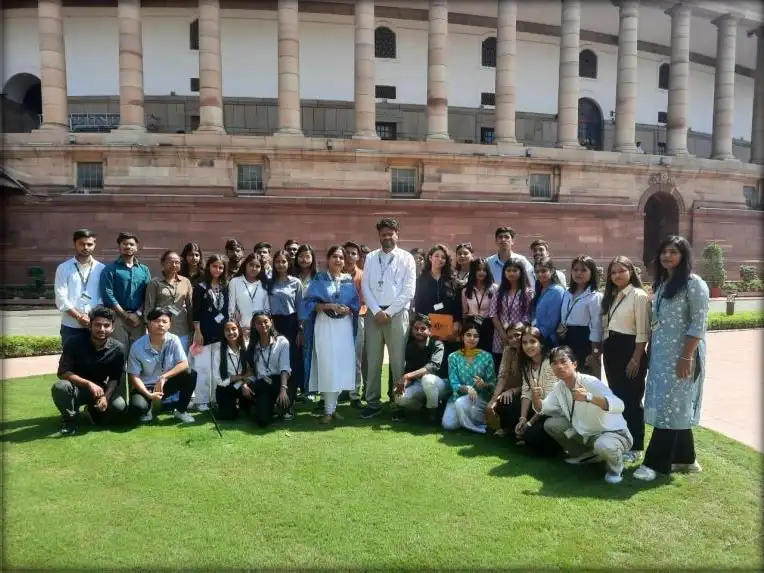Academic Session: – 2024-2025 (Odd Semester)
Date: 10 October 2024
Mode of Activity: Offline
Venue: Parliament House
Timing: 9:30 A.M. – 4:00 P.M.
Target Group: B.A. (H) Political Science (I & III year), 2024
Event/Activity Coordinator/ Coordinators: Dr.Wakeel Ahmed & Dr. Nancy Puri
Organized by: School of Liberal Arts
Introduction:
The Parliament of India is the country’s highest legislative body, and is made up of the President and two houses: the Rajya Sabha (Council of States) and the Lok Sabha (House of the People). The Parliament building is located in the New Delhi and is a symbol of India’s democracy and governance. The Central Hall is the focus of the building, and is where the Indian Constitution was framed. The Parliament is an essential building block in India’s democratic structure and serves as a way to represent the views of its citizens to the executive. Through the visit students got too aware about the relevance of numerous Government policies and its needs among the people, and which can benefit the society at large. Students got the knowledge that in most democratic countries, the Parliament plays a central role in ensuring checks and balances between the branches of government and the Members of Parliament (MPs) represent the population, debate proposed laws, and approve budgets. Indian Parliament operates under the Constitution of India, which defines its powers,
functions, and procedures. It plays a central role in the democratic governance of the country, ensuring checks and balances on the executive branch. The Parliament meets in the Sansad Bhavan in New Delhi, and its functioning is guided by procedures laid down in the Constitution and respective rules of each house.
Aims/Objectives:
The aim of the visit was to make students:
- To learn about the working of the
- To be aware of the functions of Executive
- To learn about the roles & responsibility of the
- To learn about the importance of democratic process and strength of democratic
- To introduce students to the structure and working of both the Lok Sabha and Rajya Sabha, including how bills are introduced, discussed and passed.
- To inspire students to consider careers in public service or politics and understand the significance of leadership and service to the nation.
- To explore the historical architectural significance of the Parliament building and its role in India’s journey as a democratic nation.
Content:
On 10 October 2024, a group of UG students went to a visit to the Parliament House where students were first taken to the Lok Sabha- the Lower House or the House of the people and thereafter to the Rajya Sabha – the upper House of the Council of the State where students were enlighten about the importance of both these houses, presiding officers, mode of election, seating arrangements and the recently adopted technological infrastructure to ease voting for and against bills or resolutions by members of the house. The issues discussed were far ranging and discussed the useful information like the reasons for using the iconic red and green carpets in the Rajya Sabha and Lok Sabha respectively and the translations of speeches from vernaculars to the official languages of the house- Hindi or English.
The group was thereafter led to the historic central Hall, through the lawns and corridors of the Parliament which were donned with paintings and statutes of the luminaries. Unlike the two houses, where the students were seated in their respective public galleries, they were directly led into the Central Hall which besides its current usage as a chamber for Joint sessions during the Presidential address, visit by foreign dignitaries, and other special occasion, that had a historic role in housing the Constituent Assembly who had met eleven times between 9th Dec 1946 to 26th Nov 1949 to draw up India’s constitution in this hall. Then students were moved towards the Refreshment hall and then, the tour ended with the two documentaries being screened, the first was about the framing of the Constitution of India and the second was about the images of the new Parliament building and the architectural concepts
Outcome:
It was a highly enjoyable and educative day for the students. Most of the students expressed their wished to visit again soon. Students also expressed their keen interest in gaining knowledge and moving into the new Parliament building. The students also visited various chambers of the Parliament and also saw the central hall where the British had finally handed over the control of the country back in 1947 marking the historic moment for the freedom of the country. The experience of the visit was a memorable time not just for witnessing its adorned architecture but also by learning more about the Indian law and working of the legislature proceedings. Students got aware about a stronger sense of their roles and responsibilities as citizens, recognizing the importance of voting, civic participation, and being informed about national issues. Students in future have learned about a comprehensive understanding of how laws are made, the steps involved in passing a bill, and the roles of both Lok Sabha and Rajya Sabha in shaping policies. The experience will strengthen students’ respect for the Constitution, democratic values, and the rule of law, encouraging them to uphold these principles in their personal and professional lives. Overall, a Parliament visit provides college students with a real-world understanding of democracy in action, leaving them more informed, engaged, and inspired.
Conclusion:
A group of thirty- six of UG students went for the visit to Parliament House along with the two faculties. The students understood about the Parliament of India have an important role to play in India’s national life. It is a very powerful institution, influencing decision making at every level of Indian society and acting as the representative of the people in the country. As such, it should be taken very seriously by every citizen of India, regardless of their background or location in the country. Its importance to India cannot be understated as it exists to ensure that proper laws are being made at all levels and to make sure that everyone has equal protection under the law. A visit to the Parliament of India offers to B.A. (H) students a unique and enriching experience that deepens their understanding of the democratic process. It provides them with first and exposure to the workings of one of the largest democracies in the world, showcasing how laws are made, how elected representatives debate key issues, and how governance functions at the highest level. The visit helps students to appreciate the significance of active citizenship, civic responsibility, and the importance of participating in a democratic society. Moreover, it can inspire them to contribute meaningfully to the nation, whether through public service, leadership, or informed civic engagement



